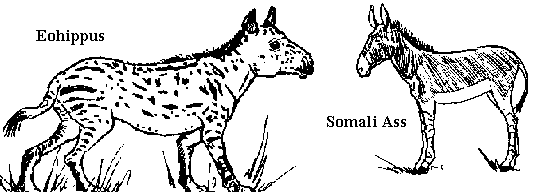
By Leah Patton
Yes, zebras are the most well-known striped equine, but donkeys, mules, and even horses can be striped to some degree.
Archeologists have unearthed the remains of a tiny mammal, Eohippus, that it the forerunner of the modem equine. But bones cannot tell us what the coat and fur of the animal might have looked like. No preserved specimens (whether trapped in a tar pit or a bog) have ever been found that would show us the markings.
Scientists do speculate that, in light of modern and known existing primitive coat patterns (such as the wild asses, zebras and Przewalski horse), stripes in some form are the logical choice.

Stripes are one of the main defenses of the zebra. In a group, the moving black and white pattern of stripes breaks up the outlines of each animal and makes it nearly impossible to single out any one individual. However, the striping patterns of zebras are known to become sparser and less distinct the further south the population range extends. The Grants (Plains) zebras, farthest North in range, have the boldest and most clearly marked pattern. The now extinct True Burchells, and extinct Cape Quagga, the furthest South of the sub-types, were so sparsely striped that only the head and neck were distinctly marked. The legs were virtually unmarked, and the pattern was broken and vague along the topline. If stripes were necessary for survival, did southern animals have less need? Or did they begin to change coloration to blend into the back-ground?
Striping, to an extent, is also found on the ass breeds, as well as modem horses. The Onager carries a wide, distinct dorsal stripe, and is the least marked of the asses. The onager has often been referred to throughout history as the demi-ass or half-ass. Although he is thought to be a true ass breed, he seems to be more horse-like in some aspects. The Somali ass, on the other hand, most resembles our familiar gray-dun donkey in coloration. Hisslate-blue color, with the light muzzle and belly, is offset by heavy black barring on the legs.
Domestic donkeys are actually descended from the African Wild asses (most probably the Nubian or Somali, or even both), and for the most part, have the "primitive" markings associated with the dun factor in horses.
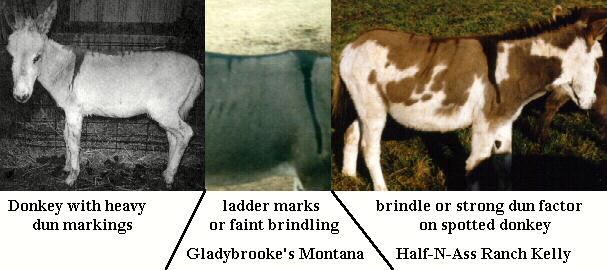
"Dun" as a coat color is actually a dilution that works on the color of the body, but does not affect the extremities (head/lower legs, mane/tail). Dun can effect either the black or red base shades, and the other dilutions (cream) as well, causing, in horses and mules, yellow dun, red dun, claybank, even a light "silver" dun. (The actual workings of the dun factor as a dilution on donkey coat colors is being researched). Dun, mainly yellow dun, but occasionally darker and tending towards brown, is the only coat color in the Przewalski (Mongolian Wild) Horse. The Norwegian Fjord horse, thought to be of primitive type, is found in all shades of dun from yellow dun to silver grullo. The distinct two-toned mane of the Fjord is the clearest example of the frosted edging, or silvering, of the mane in duns.
Gray-dun is the most common coat color in Miniature donkeys and is found frequently in the other sizes of domestic donkeys as well. Regardless of the actual base coloration of the coat, most donkeys sport the dorsal stripe and shoulder "cross" at the withers. Dun horses will always have a dorsal marking, and a rare few will have a small shoulder stripe, though usually less prominent than most donkeys. Other dun factors are eartip and ear barring, face "cobwebbing", leg barring, and frosting or silvering of the guard hairs of the mane and tail. All of these correspond to the cross and stripe, ear marks, and garters common in the donkeys. These are all thought to be possible remnants of the ancestral markings of the equines.
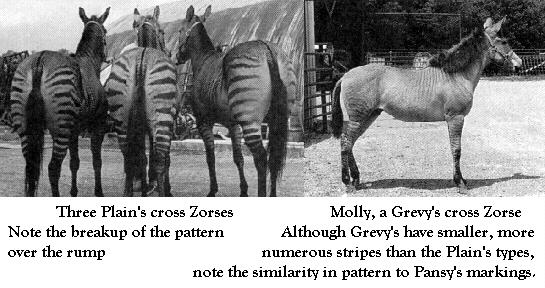
Zebras have a true dorsal stripe, although it may have other stripes that border or connect to it. The ears also sport markings almost identical to those on the donkey. The "zebra" stripes on the legs of many dun, buckskin, and even bay horses, need no explanation as they can indeed look quite similar to those on their wild African cousin.

It is interesting to note that the zebra hybrid does not necessarily keep the main pattern of striping of the zebra parent. Most hybrids, regardless of the cross of parent (grants, zorse, Grevy's, zebrass) have a striping pattern that is less distinct, but with more numerous stripes, than the zebra parent breed. Zebra striping patterns, although individual to each animal, do have noted specific guidelines" in the number of stripes that appear on the neck and body in each sub-species. Most zebra hybrid patterns break up over the loins and rump, resembling the brindle pattern to a degree.
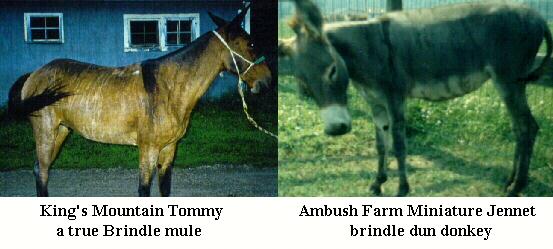
Occasionally, a horse, donkey, or mule may present an usual pattern. The brindle coloration in horses is extremely rare, and has also been noted in donkeys and even in the mule. Brindle is common in some dog breeds, and also in cattle (especially in some strains of Rodeo bucking bulls). The animal literally has a broken striping pattern mottling the body.
Brindle in the donkey is less defined than on the horse or mule, but body striping is present. Some donkeys appear to have the beginnings of the brindle pattern in the ladder marks seen dripping off the dorsal stripe. Carry this one step further, and you have a donkey with dark lines over the back and ribs. There has even been one registered Spotted Brindle donkey!
Mules always tend to have a ball with coat coloration and markings. Just as the markings of horse pinto, donkey spotted and horse appaloosa patterns are skewed on the mule, the same is true for the dun factors. Mules may have shoulder stripes that are over 4 inches wide! There may be more than one stripe at the withers, often one bold one and numerous smaller stripes fanning over the shoulder blades. The neck and rump may be darkened as if sprayed over with dark paint. The leg garters (zebra stripes) may be more numerous, wider, and bolder than on either the donkey or horse parent. Surprise mules have come from unmarked solid mares even when the jack does not have flamboyant markings!
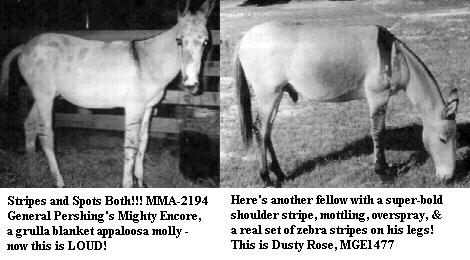
Was striping the original coloration of the equine? Examine these photos and decide for yourself!
This article has been edited for this website and does not include all the original photos in the article. We recommend you email [email protected] or contact (940) 382-6845 The Brayer, 2901 N. Elm St, Denton, TX 76201 - for a reprint of this article. This article was originally published in The Brayer (vol.31 no.1, Jan/Feb '98, pp 97-99). The website for the American Donkey and Mule Society is http://www.fuzzywunkle.net/adms/. Leah Patton also maintains other informative sites at: http://www.geocities.com/Heartland/Ridge/8974/ and http://www.donkeys.com/.
The pictures and information on this site are for informational purposes, in order to educate people on various forms of striping and primitive patterns. The pictures and information on this site are copyrighted. All rights reserved. No part may be reproduced, stored in a retrieval system, or transmitted in any form or by any means, electronic, mechanical, photocopying, recording, or otherwise, without the prior permission of the copyright holders.